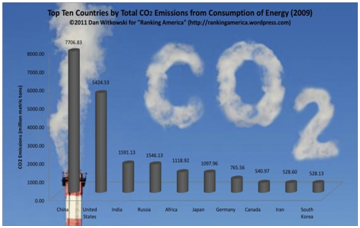Climate Change-CO2 Enrichment
Carbon dioxide is a major contributor to climate change. Scientists believe that CO2 in the Earth’s atmosphere will continue to increase, and one of the consequences may be that some of the grains humans rely on for food will be robbed of important nutrients. NPR reports on experiments done by SoyFACE (Soybean Free Air Concentration Enrichment) out of University of Illinois that measure what consequences increased CO2 in the atmosphere will have on crops. SoyFACE was designed to discover the effects of atmospheric change on the agronomy and productivity of Midwestern crops as well as to find solutions that will lead to crops better adapted to this future. One of the findings, according to NPR, is that we may have less nutritious grains in our future.
Currently, CO2 in the atmosphere is at 400 parts per million, and experiments are set up to see what happens when that rises to 500 ppm.
Experiment
The crops in an experiment are planted in fields that are in rings of carbon dioxide jets and simulate what the atmosphere is predicted to be like in 40 to 60 years. Some of the results may seem encouraging. Crops grow more quickly in higher CO2 and grow 10 percent higher. But, scientists found “5 to 10 percent reductions in nutrients like iron, zinc and protein.” This could be harmful, particularly in developing countries where nutrients are already scarce.
Source: www.mnn.com
Five common methods of generating extra amounts of CO2
- Burning hydrocarbon fuels
- Compressed, bottled CO2
- Dry ice
- Fermentation
- Decomposition of organic matter
Source: www.greenspothydroponics.com
High CO2 Makes Crops Less Nutritious


Crops grown in the high-CO2 atmosphere of the future could be significantly less nutritious, a new study published in Nature suggests. Based on hundreds of experiments in the field, the work reveals a new challenge as society reckons with both rising carbon emissions and malnutrition in the future. Scientists generally predict that crop yields could fall in a warmer world—though higher atmospheric CO2 by itself should raise yields, as plants find it easier to extract CO2 from the air to make carbohydrates. The effect climate change might have on the nutritional value of crops, as opposed to their yield, has been even murkier. Previous studies have given conflicting results. In the largest study yet, Samuel Myers of Harvard University and colleagues report that the CO2 levels expected in the second half of this century will likely reduce the levels of zinc, iron, and protein in wheat, rice, peas, and soybeans. Some two billion people, the researchers note, live in countries where citizens receive more than 60 percent of their zinc or iron from these types of crops. Deficiencies of these nutrients already cause an estimated loss of 63 million life-years annually.
Source: http://news.nationalgeographic.com
Quality and Quantity
The need to balance changes in yield against changes in the nutritional value of crops makes predicting the future of agriculture an even more complicated task:
- "Rising global CO2 increases yield and decreases water use by crops, and this is often presented as one positive of atmospheric change.
- Higher-CO2 environments will mean less nutritional crops, so that "increased quantity is at the expense of quality." CO2 enrichment experiments at Long's university have also shown that rising CO2 levels lower crops' resistance to pests.
- Global effort to develop new breeds of wheat, rice, peas, and soybeans that show resistance to higher CO2 levels.
Source: http:// crops-nutrition-climate-change-carbon-dioxide-science/
Climate change affected CO2 level in the environment
The surprise consequence of fossil fuel burning is linked directly to the rise in CO2 levels which, unlike some of the predicted impacts of climate change, are undisputed. The field trials of wheat, rice, maize and soybeans showed that higher CO2 levels significantly reduced the levels of the essential nutrients iron and zinc, as well as cutting protein levels. Rising levels of CO2 are affecting human nutrition by reducing levels of very important nutrients in very important food crops.
Fundamentally the concern is that there is already an enormous public health problem and rising CO2 in the atmosphere will exacerbate that problem further." While wheat, rice, maize and soybeans are relatively low in iron and zinc, in poorer societies where meat is rarely eaten they are a major source of the nutrients. About 2.4bn people currently get at least 60% of their zinc and iron from these staples and it is over 75% in Bangladesh, Iraq and Algeria. "This is yet another example of the impact climate change is already having on people's ability to grow and access the nutritious food they need.
Source: www.theguardian.com
Project Publications Related to CO2 enrichment
- Comprehensive ecosystem model-data synthesis using multiple data sets at two temperate forest free-air CO2 enrichment experiments: Model performance at ambient CO2 concentration
- Effects of long-term elevated CO2 treatment on the inner and outer bark chemistry of sweetgum (Liquidambar styraciflua L.) trees.
- Evaluation of 11 terrestrial carbon-nitrogen cycle models against observations from two temperate Free-Air CO2 Enrichment studies.
- Forest soil carbon oxidation state and oxidative ratio responses to elevated CO2.
- Forest water use and water use efficiency at elevated CO2 : a model-data intercomparison at two contrasting temperate forest FACE sites.
- Model-data synthesis for the next generation of forest free-air CO2 enrichment (FACE) experiments.
- Predicting long-term carbon sequestration in response to CO2 enrichment: How and why do current ecosystem models differ?
- Where does the carbon go? A model-data intercomparison of vegetation carbon allocation and turnover processes at two temperate forest free-air CO2 enrichment sites.
Source: http://climatechangescience.ornl.gov/content/free-air-co2
Conclusion:
We need major innovations in how we eat and farm to cope with our changing climate. This might include changing what we eat or shifting the way we use entire areas of land.
Climatic impacts on food security will be unmistakable. There are likely to be 9 billion people on the planet, most people will live in cities and demand for food will increase significantly.
Source: Parter et al. 2014